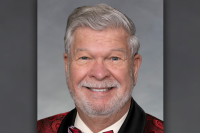An Appalachian ‘original genius’
(Note: Since its publication several years ago, this column about Evan O. Hall has sparked a number of comments. Something about Hall’s indefatigable and self-reliant cleverness reminded people of someone they, too, had known in days gone by.)
Back in the late 18th century and throughout the 19th century, America specialized as a nation in producing a special breed of citizen popularly categorized as an “original genius”; that is, they were folks self-reliant, indefatigable, and exceedingly clever when it came to improvising and making do with little or nothing. Some of these “original geniuses” had experienced formal education, many hadn’t. Most were “local characters” of one sort or another. Many were irascible and difficult to get along with, others were mild mannered.
With the spread of wealth and material goods, much of the country stopped producing their quota of “original geniuses” early in the 20th century. But the more remote areas such as the far western states and Alaska continued to do so for most of that century and even up until the present day. Because it was pretty much off the beaten track prior to World War II, the Smokies regions also continued to turn out “original geniuses” on a regular basis.
One such was Evan O. Hall, who resided with his family on Goldmine Branch in the present-day Great Smoky Mountains National Park. If from Bryson City you drive north on the infamous Road to Nowhere (i.e., Lakeshore Drive), park at the gated trailhead and walk down the Goldmine Loop Trail just opposite the parking area (not through the tunnel). After several miles you’ll come to the point where Goldmine Branch and Tunnel Branch empty into Lake Fontana. It was in this general area that Hall lived and flourished.
Images of Evan O. Hall, his wife, Ivalee Cole Hall, and their numerous children are fortunately preserved in Duane Oliver’s Along the River: People and Places - A Collection of Photographs of People and Places Once Found Along the Little Tennessee River, An Area Now part of the Fontana Lake Basin & Southern Edge of the Great Smokies Park (1998). Since not all of these are indexed, here’s a listing of the picture numbers for the Hall family that I was able to locate: 152, 229, 293, 929, 953 (the photo reproduced with this column), 1134, 1313, and 1452.
Rollins E. Justice contributed a memoir titled “Rev. Evan O. Hall” to the “Swain County Heritage” volume published in 1988. His opening paragraph reads: “Reader’s Digest used to have a regular monthly feature story, ‘My Most Memorable Character.’ Had I offered a story, and I often thought of it, it would have been about the one person outside my family who had the most influence on my life. My first teacher, Rev. Evan O. Hall, inspired ambition in learning, working, and right living.”
Related Items
The following brief synopsis of Hall’s character and activities is derived from this memoir as well as from information contained in Michal Strutin’s History Hikes in the Smokies (2003).
Evan O. Hall, the son of a Baptist minister, was born in Bryson City in 1888. By 1916 or so, he was living on Goldmine Branch with his wife, Ivalee Cole Hall (a former student he had married in 1913), and their family, which eventually numbered five daughters (Bertha, Zena, Gladys, Bonnie, and Minnie) and four sons (Greeley, Brownlow, Luther, and Stanley).
As a Baptist minister and school teacher, Hall was indefatigable, walking 10 mile round trips each day regardless of the weather on mountain trails and across swinging bridges to reach his destinations. Justice notes that Hall’s religion was “the confident, happy kind,” while as a teacher he “instilled respect for our country, its heroes, and ethical living [so that by] example and instruction he built honesty, ambition, and willingness to work into his students.”
Hall taught shape-note singing, ground cornmeal for his neighbors, sawed lumber for them at his handmade sawmill, cut tombstones for the community in his blacksmith shop (where he also shoed horses and mules), and made them coffins when they died. He was, in short, as Strutin rightly notes, “a community treasure.”
Picture #929 in Along the River is captioned: “Greely O. Hall at E.O. Hall’s Water-Powered Light Plant on Gold Mine Branch with First Radio on the Branch, a Mid-West Radio.”
Evan O. Hall had initially constructed a gristmill on Goldmine Branch, using wood from his own land to construct the housing, shafts, axel, and overshot waterwheel. The only items he didn’t construct were the millstones, which he purchased and set in place. Utilizing the power of this waterwheel (or perhaps another that he constructed) and his native ingenuity, he proceeded to wire and light his home with electricity, the first such in the area. In the evening hours, the entire Hall family no doubt enjoyed gathering around their newly-purchased, waterwheel-powered Mid-West radio.
Evan O. Hall — an “original genius” if there ever was one — and his entire family left their Goldmine Branch residence when Lake Fontana was flooded in the 1940s and moved to Haywood County. He died in 1969.
George Ellison wrote the biographical introductions for the reissues of two Appalachian classics: Horace Kephart’s Our Southern Highlanders and James Mooney’s History, Myths, and Sacred Formulas of the Cherokees. In June 2005, a selection of his Back Then columns was published by The History Press in Charleston as Mountain Passages: Natural and Cultural History of Western North Carolina and the Great Smoky Mountains. Readers can contact him at P.O. Box 1262, Bryson City, N.C., 28713, or at This email address is being protected from spambots. You need JavaScript enabled to view it..









